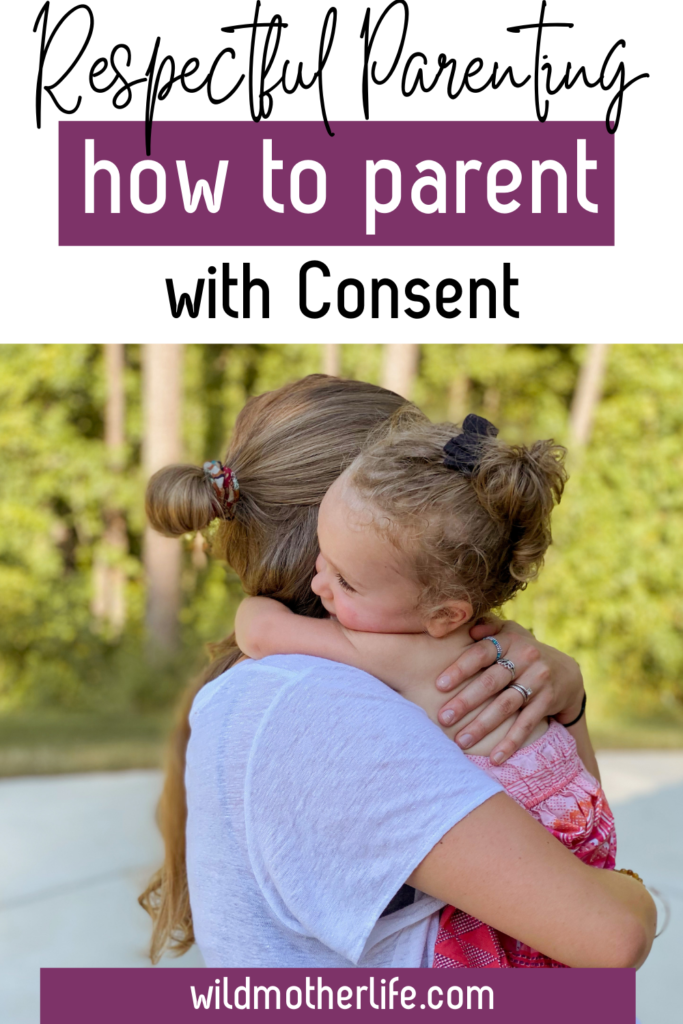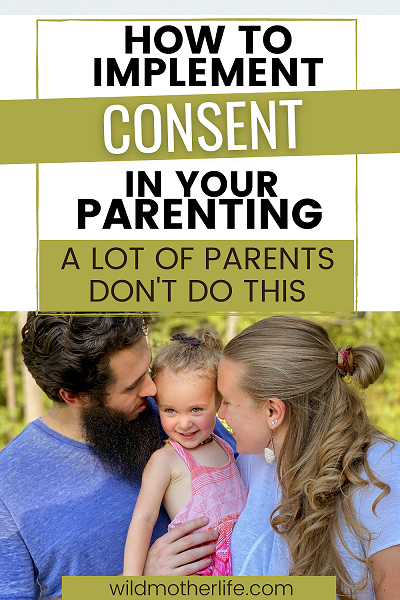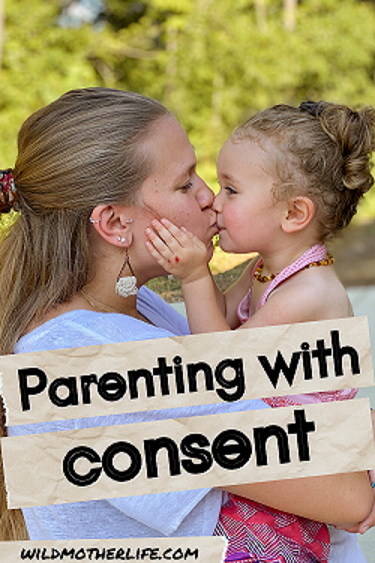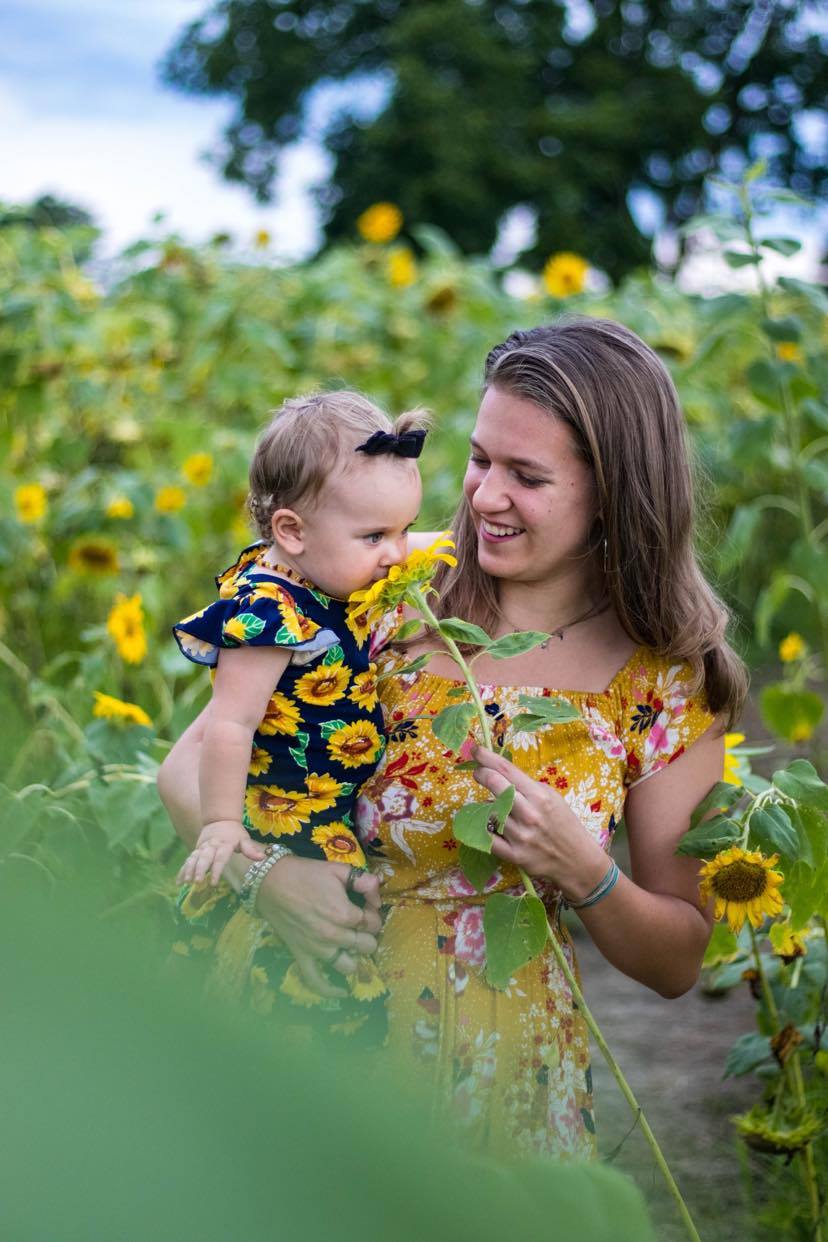
One of my main goals that I have for my children is that they grow up to be respectful of others, and maybe even more importantly, that they grow up knowing that they are worthy and deserving of others showing respect to them.
I think one of the most important ways that parents can demonstrate this to young children, is to teach them the concept of Consent. Teaching and modeling consent to our children while they’re young, sets them up to understand the concept of consent later on in life.
If we, as our children’s loving parents, respect and ask for their consent before doing things to their body like picking them up, grabbing their hand, or tickling them; they are going to grow up with the standard that THEY are the ones in control of their own body. No one can touch them if they say “no”.
Why is Consent important?
Consent is really important for not only teaching our children safety, but also teaching them boundaries.
Many of us were raised in a very “mainstream” way of parenting that normalized adults controlling and dominating children.
Because of this, it can be easy for us to not even consider how we are handling our child. Since they’re physically smaller than us, it’s easy for us to just grab them, pick them up, drag them across the parking lot, or tickle them relentlessly without considering if they are actually wanting to do these things or not.
Personally, I don’t like the message that this sends to my child. That if someone is the physically bigger person, it’s okay for them to dominate or handle another smaller person however they need to, in order to accomplish their goals.
Because we are constantly surrounded by mainstream “unconscious” parenting, it can feel intimidating to go against the crowd and parent with consent whenever possible. But it’s so important!
There are five main ways that I often see parents not considering their child’s consent. These ways are easy to miss and I’m sure I have missed them all at some point. It’s never too late to start improving and respecting our child’s boundaries!
Five Ways to Begin Respecting Your Child’s Consent and Boundaries
1. Don’t force them to show affection
In plenty of social circles, it’s still perfectly acceptable to force your child to hug/kiss someone even if they don’t want to.
“It’s time to go, give grandma a kiss.”
“Give Uncle Joe a hug.”
These situations are rather uncomfortable because it forces the child to be disingenuous with their affection…wouldn’t grandma rather have a genuine hug than one that was forced and pressured? I know I would.
It also teaches the child to not trust their own body and intuition. If they have a gut feeling that they shouldn’t hug someone, and we force it, that’s teaching them to ignore their own feelings about people and situations.
Even if we don’t force our children to hug relatives, consider the following example that I’ve heard mothers say to their children….
“I have to go now, will you please give me a hug? I’ll be so, so sad if you don’t give me a hug bye. Make mommy happy and give me a hug before I leave.”
This is teaching the child that they are responsible for other people’s emotional wellbeing. This can lead to chronic people pleasing later in life and putting their own wants and needs behind everyone else’s feelings.
2. Ask before tickling them and respect their “no” or “stop” immediately.
A lot of us probably have memories of being tickled so hard that we couldn’t even breathe…it wasn’t fun anymore, even though our bodies were laughing reflexively. I remember trying to say “stop!” but I couldn’t breathe, so I couldn’t get the words out. And even if I did, they didn’t usually listen to my “stop”.
I don’t think this is respectful of a child’s consent at all.
Most parents mean it in a fun way. We like to tickle our children because we love to hear them laugh. There’s nothing wrong with that per se, but there is a RIGHT way and a WRONG way to go about it.
A great start is to just ask if they want to be tickled first…”hey can I tickle you?!”. Respect their “no” if they don’t want to be tickled, and if they say yes, don’t overdo it.
Sometimes we will ask my daughter, “do you just want one tickle?” and she will giggle and say “yes just a little tickle!” We will poke her belly, she’ll giggle, and we’re both mutually having fun.
3. Ask for their permission, or at least give them a warning, before picking them up when they are involved in an activity.
When you think about it, we would never just walk over to an adult who was focused on something and started cleaning up what they were doing without asking or telling them first. Because that’s rude.
It’s the same with our kids though. When they are focused on an activity, they are connecting neurons and learning and growing, and they deserve the respect of us asking before we just pick them up or clean up their activity.
Just a little heads up is bound to save everyone some frustration too!
4. Teach them to ask before they hug/kiss another child or friend.
This one can be so hard to do, because it’s so cute when we see our kids being affectionate and wanting to hug their toddler friends!
I think this situation is a great time when we can gently start to teach boundaries to our child while they’re still little and the situations are completely safe. There’s no inherent danger with toddlers hugging eachother, or even a toddler “forcing” a hug on a friend.
So it’s a great situation to start teaching boundaries and personal consent!
When your child approaches a friend to hug them and you aren’t sure if it will be well received by the other child, you could just say something like, “Oh hey, let’s ask Johnny if he wants a hug first! Hey Johnny, is it okay if Sarah gives you a hug? No? That’s okay! What about a high-five instead?!”
No sweat, just calm, confident and laying the groundwork of consent from a young age.
5. Model our own Boundaries
Obviously as parents, we love affection from our children, so we probably are never going to tell them that we don’t want a hug. But it’s still a good idea to demonstrate our own physical boundaries sometimes to show the child that it’s okay to set boundaries around your own body if you’re uncomfortable with something.
A great example of this is nipple twiddling while nursing toddlers. For many moms, nipple twiddling is a very unpleasant and triggering sensation.
I think it’s a perfect opportunity to teach your toddler that you won’t let them do something that hurts your body.
“Oh wow, I feel you pinching my skin. I know that’s comforting for you, but that actually hurts my skin when it’s pinched like that. I’m going to block your hand because I don’t want you to do that to me anymore.”
And then following through and covering your skin or gently blocking their hand.
Same thing goes for when our little ones are frustrated and may try to hit or bite us.
“Oh wow it seems like you’re frustrated, but I can’t let you hit me because that hurts my body. I’m going to block your hand/set you down/give you this pillow instead.”
It’s okay to have our own boundaries. This is a great way to show our children that it’s also okay for them to set their own boundaries if something happens that they are uncomfortable with.
A note about consent in tricky situations
Now obviously there are some circumstances due to safety or hygiene where parents have to do something to their child, even if the child does not want it to be done. Some examples include taking a bath, changing dirty diapers, buckling in the car, holding hands to cross the street etc.
I know a lot of children go through phases where they dislike some of these things and will scream “no no no!” while you do it. It can feel really hard for us, but the reality is, you HAVE to buckle them in their carseat, because you have to keep them safe. And there are plenty of respectful ways to handle situations like this!
However, I do think a lot of the time parents miss plenty of opportunities to respect their child’s consent that are NOT safety or hygiene related. These are the times that I listed above.
Sometimes we have to help our child do things, even if they don’t like it, and that’s okay. But I want parents to be more mindful and conscious of all the times that they CAN respect their child’s consent.
Remember, teaching them consent while they’re toddlers, establishes safety and boundaries that they will carry with them for the rest of their life.
And that’s what I want for my kids – to respect others and to know that they are worthy of respect.
Other Respectful Parenting Articles You Might Like:
Stop Distracting Your Toddler When They’re Upset
How to Prevent Toddler Tantrums with Respectful Parenting
Watch this in video form!



Hey, I'm Victoria!
I'm so glad you're here, sweet mother!
My goal is to inspire you to remember your primal roots & live a WILD life in alignment with nature. On my blog I empower you to use herbs and natural remedies to keep your family healthy, teach you how to eat a nourishing, traditional foods diet, and inspire you to raise your babies consciously and respectfully.

